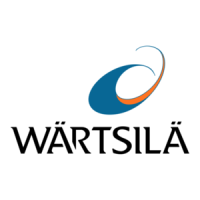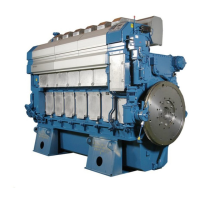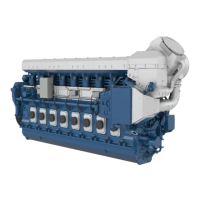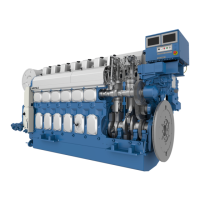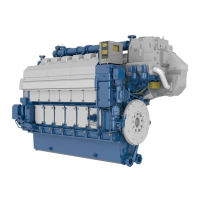Do you have a question about the Wartsila 16V34DF and is the answer not in the manual?
Details engine specifications like bore, stroke, displacement, valves, and configuration.
Presents output ratings for main engines and generating sets across different configurations.
Explains output reduction factors based on methane number and charge air temperature.
Defines acceptable limits for engine parameters below nominal speed.
Discusses controlled load increase, loading ramps, and generator overload capabilities.
Detailed specifications for the Wärtsilä 6L34DF engine across different emission standards.
Detailed specifications for the Wärtsilä 9L34DF engine across different emission standards.
Detailed specifications for the Wärtsilä 12V34DF engine across different emission standards.
Detailed specifications for the Wärtsilä 16V34DF engine across different emission standards.
Provides guidance on time between overhauls and expected component lifetimes.
Specifies quality requirements for gas and liquid fuels used by the engine.
Lists properties and limits for natural gas used as fuel, including LHV and methane number.
Details specifications for Marine Diesel Fuel (MDF) and Heavy Fuel Oil (HFO).
Explains dual fuel operation modes: gas, diesel, and backup.
Covers internal and external fuel gas systems, including components and safety features.
Specifies requirements for engine lubricating oil based on fuel standards and viscosity.
Details viscosity class, alkalinity (BN), and fuel grade impact on oil choice.
Specifies requirements for fresh water quality in the engine cooling system.
Guidelines for designing exhaust systems to manage gas accumulation and explosion pressure.
Covers IMO regulations, MARPOL Annex VI, and NOx emission standards.
Explains primary and secondary methods for reducing diesel engine exhaust emissions.
Describes the UNIC C3 automation system architecture and its modules.
| Cylinder Arrangement | Vee |
|---|---|
| Number of cylinders | 16 |
| Bore | 340 mm |
| Stroke | 400 mm |
| Power output | 800-900 kW/cylinder |
| Fuel Type | Natural gas, heavy fuel oil (HFO) |
| Cooling system | Water cooled |
| Emissions Compliance | IMO Tier III |
| Speed | 720-750 rpm |
| Engine Speed | 720-750 rpm |
